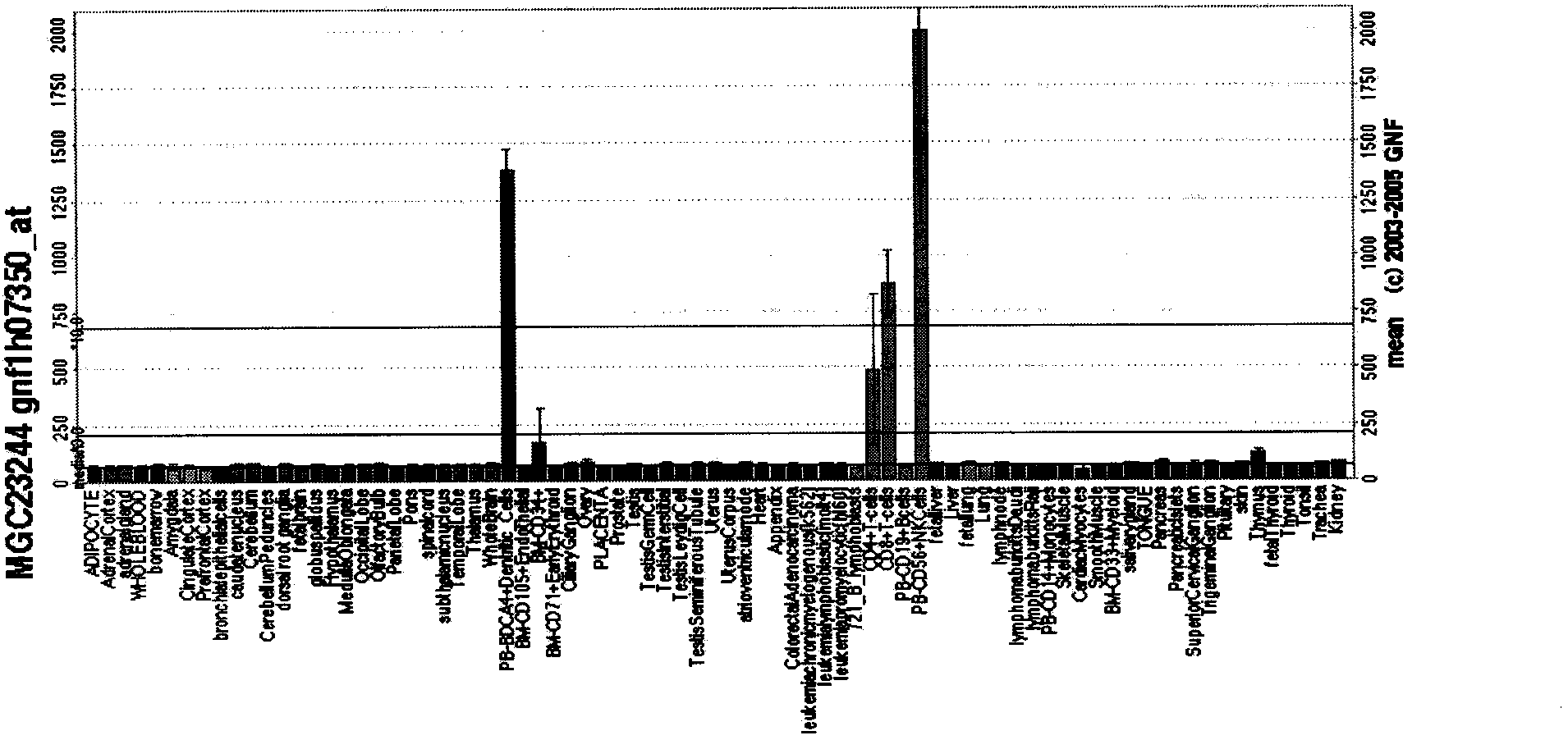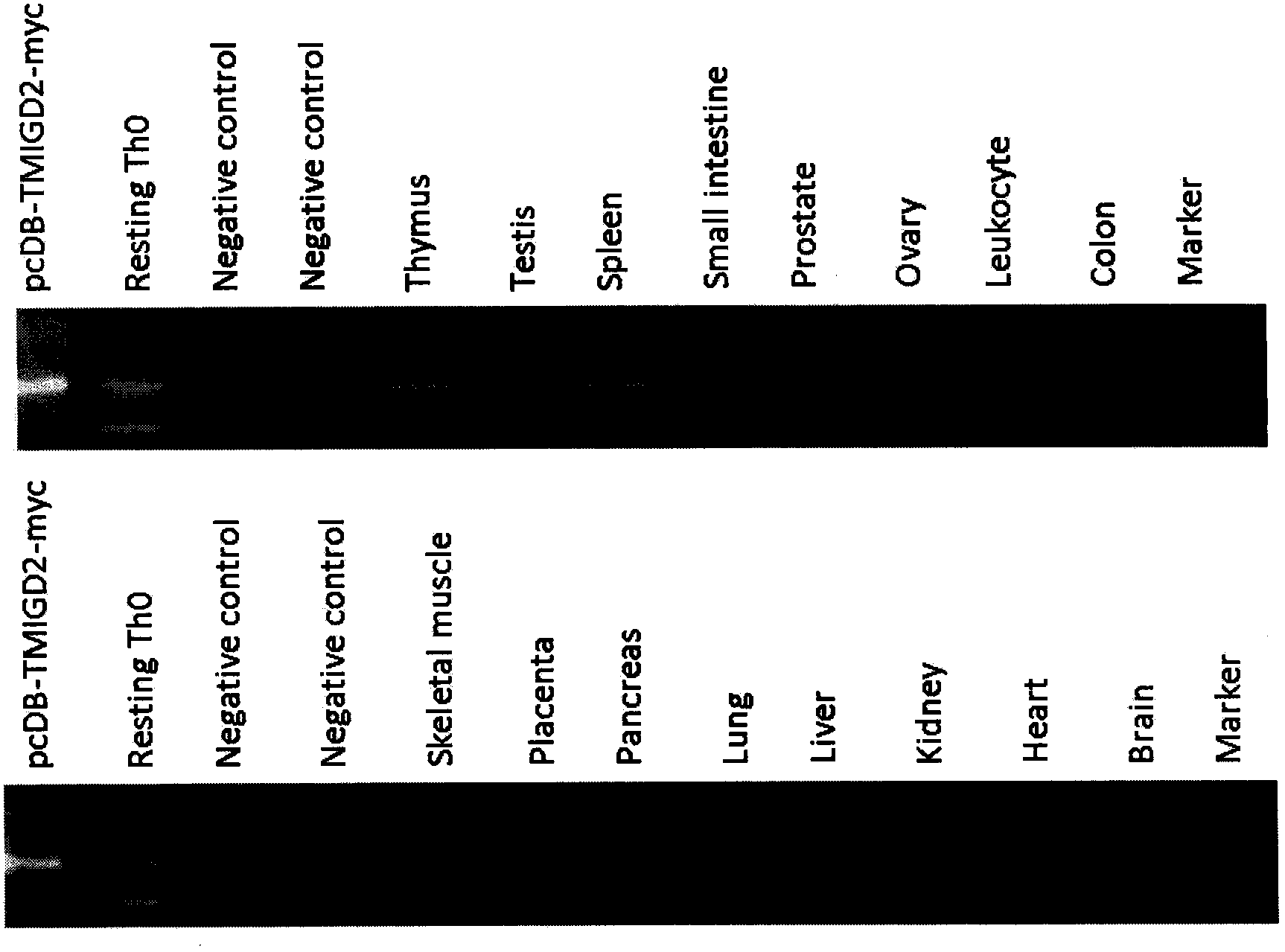Applications of novel human latent leukocyte differentiation antigen TMIGD2 discovered by utilization of immunomic technology
A protein and antibody technology, applied in the field of use and preparation of polynucleotides and polypeptides, can solve problems such as non-functional reports
- Summary
- Abstract
- Description
- Claims
- Application Information
AI Technical Summary
Problems solved by technology
Method used
Image
Examples
Embodiment 1
[0038] Example 1. Selection of Human Potential Leukocyte Differentiation Antigen TMIGD2
[0039] In order to find candidate immune cell membrane molecules that function in the immune system, Peking University Human Disease Gene Research Center cooperates with the National Human Genome North Research Center, using the strategy of immune genomics, with the whole genome as the background, according to the expression and structural characteristics of immune cell membrane molecules , and formulated the following four selection criteria: (1) Highly expressed in immune cells; (2) Characteristic expression profile, that is, specific expression only on certain types of immune cells; (3) Preference for single Transmembrane type I and type II cell membrane protein; (4) There is no function report yet. To this end, the inventors selected 721_B_lymphoblasts, CD4+T-cells, CD8+T-cells, PB-BDCA4+Dentritic_Cells, PB-CD14+Monocytes, PB-CD19+Bcells, PB-CD56+NKCells, BM-CD33+Myeloid , BM-CD34+, ...
Embodiment 2
[0041] Example 2. Carry out cell expression analysis of human TMIGD2 by RT-PCR method
[0042] First, total cellular RNA was extracted. Harvest 2~10×10 6 For different cells, add appropriate amount of TRIZOL reagent. Incubate at room temperature for 10 minutes to completely separate the nucleoprotein fraction. Add 0.2ml chloroform per ml TRIZOL, vortex for 15 seconds, and place at room temperature for 2-3 minutes. Centrifuge at 12000g for 15 minutes at 4°C. After centrifugation, take the upper aqueous phase and place it in a new EP tube, add 0.5 ml of isopropanol to each ml of TRIZOL, and let it stand at room temperature for 10 minutes. Centrifuge at 12000g for 10 minutes at 4°C. Discard the supernatant and wash with 1 ml of 75% ethanol per ml of TRIZOL. Centrifuge at 7500g for 5 minutes at 4°C. Discard the supernatant and let the precipitated RNA dry naturally at room temperature. Add appropriate amount of DEPC water to dissolve and mix well. Perform RNA quantificati...
Embodiment 3
[0046] Embodiment 3 Human TMIGD2 recombinant expression
[0047] Firstly, the extracellular domain fragment of TMIGD2 was amplified by PCR. Use the primers described in SEQ No.13 and 14 to carry out PCR amplification with pcDB-TMIGD2-myc-his as a template, then use Nco I and Xho I to double-enzyme digest the PCR product and prokaryotic expression vectors pGEX4T-1 and pET -32a-c(+), the TMIGD2 ectoregion fragment after enzyme digestion was connected to two kinds of vectors at 16°C for 12 hours, transformed into E. coli DH5α, the transformant was grown on LA plate medium, the clone was picked, and the plasmid was extracted. PCR identification, selection of positive clones, and sequencing, pGEX4T-1-TMIGD2 is the expression plasmid of the extracellular segment of TMIGD2 with a GST tag at the N-terminus and the signal peptide is removed, and pET-32a-c(+)-TMIGD2 is an expression plasmid with a GST tag at the N-terminus. The expression plasmid of TMIGD2 extracellular segment with Tr...
PUM
 Login to View More
Login to View More Abstract
Description
Claims
Application Information
 Login to View More
Login to View More - R&D
- Intellectual Property
- Life Sciences
- Materials
- Tech Scout
- Unparalleled Data Quality
- Higher Quality Content
- 60% Fewer Hallucinations
Browse by: Latest US Patents, China's latest patents, Technical Efficacy Thesaurus, Application Domain, Technology Topic, Popular Technical Reports.
© 2025 PatSnap. All rights reserved.Legal|Privacy policy|Modern Slavery Act Transparency Statement|Sitemap|About US| Contact US: help@patsnap.com



